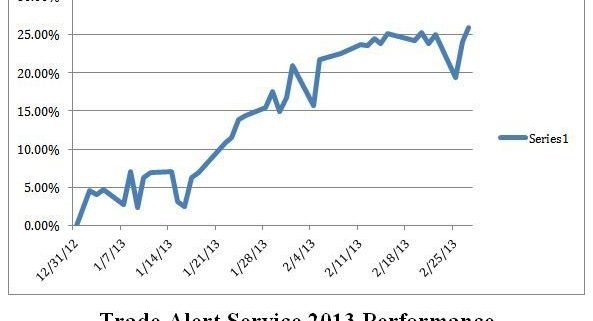Global Market Comments
March 1, 2013
Fiat Lux
Featured Trade:
(TRADE ALERT SERVICE CLOCKS 26% GAIN IN 2013)
(A CONVERSATION WITH THE BOOTS ON THE GROUND),
(DINNER WITH NOBEL PRIZE WINNER JOSEPH STIGLITZ)
The Trade Alert Service of the Mad Hedge Fund Trader has posted a 26.01% profit year to date, taking it to another new all time high. The 26-month total return has punched through to an awesome 81.06%, compared to a miserable 15% return for the Dow average during the same period. That raises the average annualized return for the service to 36%, elevating it to the pinnacle of hedge fund ranks.
My bet that the stock markets would move sideways to up small during the month of February has paid off big time, as I continued to run sizeable long positions in the S&P 500 and the Russell 2000 (IWM). In the end, the Dow gained only 80 points for the month, an increase of only 57 basis points. My substantial short volatility positions are contributing to profits daily. I booked nice profits from holdings in American International Group (AIG) and copper producer, Freeport McMoRan (FCX). I also prudently doubled up my short positions in the Japanese yen.
It has truly been a month where everything is working. Even my short positions in deep out of the money calls on the (SPY) are substantially contributing to my P&L. While the (SPY) has been going up, it has not been appreciating fast enough to hurt the position. In the meantime, I have been able to dodge the bullets that have been killing off other hedge funds, including those in gold (GLD), oil (USO), and commodities (CORN), (CU).
All told, the last 18 consecutive recommendations of the Trade Alert Service have been profitable. I have eight trades to go to beat this record. Watch this space.
Global Trading Dispatch, my highly innovative and successful trade-mentoring program, earned a net return for readers of 40.17% in 2011 and 14.87% in 2012. The service includes my Trade Alert Service, daily newsletter, real-time trading portfolio, an enormous trading idea database, and live biweekly strategy webinars. To subscribe, please go to my website at www.madhedgefundtrader.com, find the ?Global Trading Dispatch? box on the right, and click on the lime green ?SUBSCRIBE NOW? button.
I have spent many hours speaking at length with the generals who ran our wars in the Middle East, like David Petraeus, James E. Cartwright, and Martin E. Dempsey. To get the boots on the ground view, I attended the graduation of a friend at the Defense Language Institute in Monterey, California, the world's preeminent language training facility.
As I circulated at the reception at the once top-secret installation, I heard the same view repeated over and over in the many conversations swirling around me. While we can handily beat armies, defeating an idea is impossible. With the planet's fastest growing population, Muslims are expected to double from one to two billion by 2050, the terrorists can breed replacements faster than we can kill them. The US will have to maintain a military presence in the Middle East for another 100 years. The goal is not to win, but to keep the war at a low cost, slow burn, over there, and away from the US.
I have never met a more determined, disciplined, and motivated group of students. There were seven teachers for 16 students, some with PhD's and all native Arabic speakers. The Defense Department calculates the cost of this 63-week, total emersion course at $200,000 per student.
They are taught not just language, but also the history, culture, and politics of the region as well. I found myself discussing at length the origins of the Sunni/Shiite split in the 7th century, the rise of the Mughals in India in the 16th century, and the fall of the Ottoman Empire after WWI, and this was with a 19 year old private from Kentucky whose previous employment had been at Wal-Mart! I doubt most Americans her age could find the Middle East on a map. Students graduated with near perfect scores. If you fail a class, you get sent to Afghanistan, unless you are in the Air Force, which kicks you out of the service completely.
As we feasted on hummus and other Arab delicacies, I studied the pictures on the wall describing the early history of the DLI in WWII, and realized that I knew several of the participants. The school was founded in 1941 to train Japanese Americans in their own language to gain an intelligence advantage in the Pacific war. General 'Vinegar Joe' Stillwell said their contribution shortened the war by two years. General Douglas McArthur believed that an army had never before gone to war with so much advance knowledge about its enemy. To this day, the school's motto is 'Yankee Samurai'.
My old friends at the Foreign Correspondents' Club of Japan will remember well the late Al Pinder. He spent the summer of 1941 photographing every Eastern facing beach in Japan, successfully smuggled them out hidden in a chest full of Japanese blow up dolls and sex toys. He then spent the rest of the war working for the OSS in China. I know this because I shared a desk in Tokyo with Al for nearly ten years. His picture is there in all his youth, accepting the Japanese surrender in Korea with DLI graduates.
I Guess I Should Have Studied Harder
Global Market Comments
February 28, 2013
Fiat Lux
Featured Trade:
(SUNDAY WITH PRESIDENT JIMMY CARTER)
When I heard that our 39th president, former governor of Georgia, and Nobel Peace Prize winner, Jimmy Carter was coming to town, I moved heaven and earth to meet him.
I served in the White House Press Corps as the The Economist correspondent during the latter part of his term, and was dying to get answers to issues that were then classified, or unknowable.
It was tense and politically charged, but a highly productive time. He signed a treaty handing back the Panama Canal, brokered the Camp David accords between Israel and the Palestinians, signed the SALT II Treaty limiting nuclear weapons with the Soviet Union, and normalized diplomatic relations with China.
Then the good will created by these accomplishments went up in smoke when Iran seized 52 hostages by storming the American embassy in Tehran, an ordeal that lasted 444 days. It was a national nightmare and a very dark time for America. That smashed his reelection chances in 1980, and paved the way for Ronald Reagan to ascend to the presidency.
During the seventies, his administration was looking for an American who spoke fluent Japanese and knew Japan?s steel industry inside out. It turned out that I was the only one, having covered the industry on a daily basis for the Sydney based? Financial Review.
I was offered an appointment as Deputy Assistant Secretary of the Treasury for International Affairs, which I turned down because the pay was too low ($15,000 a year for a G-14). It was the biggest mistake I ever made, leaving millions of future potential lobbying fees on the table. Such are the errant ways of youth.
Carter showed up to our meeting in a modest grey suit, red tie, and a thinning mane of pure white hair. He was animated, with a relaxed sense of humor, but answered his questions with rapid-fire succession. Not only was he fully briefed on developments in every country of the world, he personally knew the leaders of many. Touch on issues he deeply cared about, and he responded with fire and brimstone.
One of the great things about interviewing old ex-presidents is that either the events in which they have confidential knowledge have passed their statute of limitations, or they can?t remember if they were classified or not. So having an extended conversation can be very interesting, to say the least. Such was the case with my two hour talk with Jimmy Carter. I will try to summarize what he said.
The former president argues that the United States is now the most unchallenged superpower in history. It is not only the most powerful nation on earth, but in all of human history.
However, despite this unprecedented strength, the country is pulling back from the ideals that made it great in decades past. Once the leader on the environment, we now lag far behind Europe. By using drones to assassinate Americans abroad, we are disavowing the Geneva Convention. Our commitment to human rights has wavered. Half of the 160 prisoners at Guantanamo Bay have never been charged, and are effectively serving life sentences. We now have the largest prison population in the world, up sevenfold in 30 years.
We are the most warlike nation in modern history, and have almost continuously been involved in combat for the past 70 years. The long list of adversaries includes Korea, Lebanon, Vietnam, Cuba, Cambodia, Laos, Grenada, Panama, Nicaragua, Iraq, Serbia, Kosovo, Afghanistan, Iraq again, Somalia, Libya, and most recently Yemen. Next on the menu are Syria, Iran, and Mali. The leadership of many countries live in terror of us. Such a long history of conflict reflects a serial lack of desire to negotiate on our part.
We have retreated from our domestic principles as well. The concentration of wealth at the top continues unabated, with the top 1% seeing a 400% rise in net worth, while the rest of us have seen declines. College tuition has soared from 4% to 10% of family income. Poverty has risen by 31% in just the past five years.
Massive infusions of money into the political system have created a hopeless gridlock in the government, making it impossible to do anything about our problems. His own presidential campaign in 1980 cost nothing, as it was entirely financed with public money. In 2012 both parties spent $6 billion.
Most of this money went into negative TV advertising that so poisons the atmosphere that the winners refuse to talk to each other when they get to Washington. Carter thinks that the Supreme Court?s Citizens United decision, open the way for unlimited anonymous corporate donations, was ?stupid.?
The native of Plains, Georgia said that it was not clear that Iran had decided to develop nuclear weapons, but they certainly had the means to do so. Even if they had such an offensive capability, it is unlikely they would ever use it. Israel has over 200 operational nukes, and the slightest hostile move by Iran would result in them being wiped off the face of the earth. Iran has no desire to commit national suicide.
Nor does North Korea, which has to face America?s 5,000 nuclear bombs. The Clinton administration had a peace treaty written up and ready to sign with Kim Il Sung in the late nineties, ending 45 years of hostilities. Then George W. Bush got elected president and he threw it in the trash. That panicked the North Koreans into a crash program to develop nuclear weapons and intercontinental missiles. The first successful test occurred in 2006.
Carter is a regular traveler to the Hermit Kingdom in order to keep back channels open, where he sees starving children as the cruel face of our economic sanctions. He still believes that North Korea would dump its nukes if we reoffered the peace treaty, when the proper initiatives were taken.
Carter has been visiting China since 1949, when his sub made a brief stop just before the Nationalist collapse. He personally knows the new leader, Xi Jinping, well, and thinks the Middle Kingdom will never pose a military threat to the US. The Carter Center has monitored elections in 650,000 towns and villages there for the past 15 years, where the communist party is not active.
He sees our largest trading partner moving towards full democracy over time. He is assisting in implementing the country?s first Freedom of Information Act. In fact, China has the world?s most rapidly growing Christian population today, with total numbers soon to exceed 100 million. They are also the planet?s largest publisher of the Bible.
The former president is discouraged about developments in Israel, where the Benjamin Netenyahu administration seems hell bent on colonizing the West Bank as quickly as possible. This eliminates the possibility of a two state solution, which the Palestinians and every other country in the Middle East have already said they would sign on to.
Carter sees the Arab Spring as a hugely pro-American development, as every country in which it has unfolded has moved from dictatorship to democracy. But don?t expect every country to elect a leadership in our image. Of course, Egypt is going to choose the Muslim Brotherhood, a country that is 90% Muslim! The new Mohammed Morsi government was the most moderate of several alternatives, and should work well with the US. (He has a PhD in engineering from one of my alma maters, the University of Southern California).
What makes Carter such an interesting person to speak to today is that he has become the most active and hard working ex-president in history. For the last 31 years he has run the Carter Center , a well funded non profit that promotes global peace, advances public health, monitors international elections, and promotes women?s rights.
The Carter Center has just monitored its 93rd foreign election, in the West African country of Sierra Leone. It has almost completely eliminated Guinea Worm, cutting the number of global cases from 3.5 million to only 542. It has treated 75 million cases of trachoma and 12.8 million cases of river blindness.
Despite his strong anti-war stance, Carter insists that he is not a pacifist. He has served on two battleships and three submarines, and came to office with more military experience than any other modern president after Eisenhower.
Jimmy Carter grew up on a farm in rural Georgia during the Great Depression. Childhood diversions included raising a great number of different birds and animals, and searching for pottery fragments left by ancient Indians who once inhabited the land.
He wanted to become a naval officer from the age of five, following in the footsteps of an admired uncle in the US Asiatic Fleet of the twenties and thirties. That led him to Georgia Tech, Annapolis, and eight years in the Navy. His specialty was nuclear engineering, and he served on the Seawolf, America?s second nuclear submarine.
Carter?s memory for numbers was nothing less than stunning for someone born in 1924. When he was growing up in Plains, his father charged him with managing the black tenant farmers. He became a second son to many families, often sleeping over in ramshackle shacks sharing bed bug bites.
He paid daily wages of $1 for a man, 50 cents for a woman, and 25 for a child. Finally, the workers went on strike because they were starving. His father threatened to fire everyone to show that organizing labor was futile. But he gave them the quarter raise they needed after the following New Year so they could eat. It was definitely another time and another place. When I told Carter I wanted to be like him when I was 88, he laughed.
I had to ask him about Argo, the Iran hostage rescue movie nominated for Best Picture at the Academy Awards. He said that it greatly overplayed the role of the Americans. After being turned away by the British embassy, the Canadians ended up doing 90% of the work, and bore most of the risk in the effort to spirit six Americans out of the country.
If it were discovered they were hiding Americans, they too would have been overwhelmed and taken prisoner. To observe the letter of the law, the Canadian Parliament met in secret for the only time in its history to give the approval. The facts aside, Carter said Argo was a wonderfully entertaining movie.
That was spoken like a true diplomat.
Global Market Comments
February 27, 2013
Fiat Lux
Featured Trade:
(WHY THE MARKETS COULD CARE LESS ABOUT SEQUESTRATION),
(BE CAREFUL WHO YOU SNITCH ON)
They say a picture is worth 1,000 words. The map below is worth a PhD thesis, and perhaps a weighty tome. Prepared by my friends from government data at the online financial site run by Henry Blodget, Business Insider, it ranks the states most impacted by the sequestration of federal spending that starts on Friday, March 1. Then, some $85 billion in annual outlays grind to a complete halt. Call it ?F? day.
It confirms what I have known for a very long time, that the US government is basically a giant recycling mechanism that sucks money out of blue states and spends it in red states. The map shows that by far, the biggest beneficiaries of Washington?s largess are Virginia, Kentucky, South Carolina, Mississippi, Alaska, Hawaii, Missouri, Maryland, Texas, and New Mexico. These are the states that stand the most to lose from the 8.5% across the board cut in spending that is about to take place. It is a broad-brush generalization with some exceptions, but you get the picture.
The states that have the least to lose are New York, New Jersey, Oregon, Illinois, Michigan, Minnesota, Ohio, Iowa, Nebraska, and California. These happen to be the states that are the biggest contributors of tax revenue to the Treasury. The two richest, California and New York get back 78 cents in government spending for every dollar in taxes they pay into the system. Alaska and Hawaii each receive a whopping $7 in spending for each dollar raised, while Washington DC get?s a stratospheric $8. Even during these difficult budget times, new museums are under construction on the Great Mall, as I write this.
It?s not hard to figure out where all this money is going. The overwhelming share of this disproportionate red state spending is for defense. This originally began nearly 100 years ago because the big military bases set up during WWI and WWII could only be built where land was cheap and plentiful. That was much more easily found in the middle of nowhere, in the Midwest and the South, rather than on the populous coasts.
The recipients of all this defense spending is easily found in Kentucky (101st Airborne Division at Fort Campbell, Fort Knox), South Carolina (Parris Island Marine Corp training center), Mississippi (Columbus AFB), Alaska (Elmendorf AFB), Missouri (Whiteman AFB), Maryland (Andrews AFB, the Naval Academy), Texas (Fort Hood), and New Mexico (Los Alamos National Labs). In Hawaii (Pearl Harbor, Bellows AFB) and Virginia (Norfolk Naval Shipyard, Quantico) the Navy is responsible for the bulk of the expenditures.
This is why red state representatives in congress are wringing their hands with such distress, as military spending represents such a large proportion of their local GDP. Sequestration brings a sharp slowdown of money pouring into their states. The businesses of their largest donors will noticeably slow. Blue state representatives are far more relaxed, as sequestration effectively means a slowdown of deflationary cash outflows from their states.
Social spending is understandably the greatest where you have the most people, on the coasts. But it represents a tiny proportion of the local economy, and will impact few jobs. The economies of big states are primarily driven by the private sector, such as in New York (banking, finance, media, telecommunications), Illinois (finance, manufacturing, agriculture), and California (technology, housing, international trade).
I doubt we will even notice the sequestration here in the Golden State, unless we turn the TV on, or try to leave. That?s why I think sequestration is going to happen. This time, there will be no last minute pull back from the precipice.
In fact, sequestration could well be the big yawner of the year. It might be the Y2K of this decade. Remember when Armageddon was predicted for the year 2000, but in the end, someone?s toaster didn?t work in Peoria, Illinois? And that was a really old toaster.
This is what the financial markets have been telling us for the past three months. Notice that, with only four days until the disastrous deadline, the stock markets were breaking to new five-year highs, until they were temporarily delayed by the Italian election.
The worst-case scenario seems to be that GDP will slow by a mere 25 basis points. But this will be on the coattails of a dramatic decline in the government deficit. Notice also that the financial markets are headquartered in states that will be minimally impacted by sequestration cuts.
These interstate cash flows go a long way to explain why we have gridlock in Washington. It is the status quo that benefits the most from inaction and has the most to lose from change. President Obama knows this and it is why he is playing such hardball with the Republicans. You can?t make an omelet without breaking a few eggs.
It also explains why there is such a massive building boom for new commercial office space in our nation?s capital. The Citizen?s United ruling, which legalized unlimited anonymous corporate donations, has opened the floodgates for cash to hire new armies of new lobbyists. They keep the money continuing to flow to the hinterlands, and the gravy train running. Knowing all this, it is sometimes easy for me to get discouraged when contemplating our country?s future.
It?s not like our lives depend on all this extra spending on defense. The US has not had an industrial strength enemy since the collapse of the Soviet Union 20 years ago, which is now a faint shadow of its former self. They just sold us the last of their excess weapons grade plutonium to run our nuclear power plants.
Al Qaida has been reduced to a few hundred religious fanatics hiding out in Pakistani basements, and a few sleeper cells, with rather short lifespans. That?s why they have no retirement plan.
Yet US defense spending has doubled to $800 billion since 2000. The sequester will bring the first measurable decline in such spending since the peace dividend of the nineties. Why are we spending so much money without any real enemies?
China?s military is almost exclusively aimed at controlling its own population. The one small, second hand aircraft carrier they acquired from the Ukraine is to protect their oil supplies from the Middle East as we withdraw our forces from there. America has been at war almost non-stop since WWII. Since 1949, China carried out a single invasion only 20 miles into Vietnam, and then retreated after two weeks.
I am not alone with these views. The Joint Chiefs of Staff happen to agree with me, as do the majority of serving generals and admirals, and the CIA. They would much prefer husbanding scarce resources for cyber warfare, special operations, advanced drones, and training. Blowing money on big-ticket, but useless cold war weapons systems, like nuclear aircraft carriers and submarines, and the F-22 and X-35 fighters, just to boost employment in favored congressional districts, is the greater threat to our national security. Talk to anyone who has ever been in the military, and the tales of waste and inefficacy on an industrial scale abound.
Imagine if, instead of committing $1 trillion to the war in Iraq, we had spent it on cyber warfare? Imagine what the Internet would be like now? Imagine what online commerce would be like? It boggles the mind.
Raise such concerns about this unnecessary spending, and you get called a pacifist, a coward, and a traitor. Wasn?t the peace symbol the footprint of the American chicken? That doesn?t work with me. I have been assisting the US military on and off for 40 years, from intelligence, to flying hopelessly risky missions, to grief counseling of Marine widows, orphans, and parents. I am a veteran of six wars, and still carry enough lead to set off metal detectors. Call someone else a pacifist.
I think when sequestration starts on Friday, I?ll go for a long hike. I hope congress does too, down a short pier.
Do We Really Need Ten?
Buried in the recently passed Dodd-Frank financial reform bill are massive financial rewards for turning in your crooked boss. The SEC is hoping that multimillion-dollar rewards amounting to 10%-30% of sanction amounts will drive a stampede of whistleblowers to their doors with evidence of malfeasance and fraud by their employers.
If such rules were in place at the time of the settlement with Goldman Sachs (GS), the bonus, in theory, could have been worth up to $500 million. Wall Street firms are bracing themselves for an onslaught of claims, legitimate and otherwise, by droves of hungry gold diggers looking for an early retirement.
Don't count on this as a get rich quick scheme. Government hurdles to meet the requirement of a true stoolie can be daunting. The standard of evidence demanded is high, and must be matched with the violation of specific federal laws. Idle chitchat at the water cooler won't do. Litigation can stretch out over five years, involve substantial legal costs, and often lead to a non-financial settlement with no reward. For those who do deliver the goods, death threats from defendants are not unheard of.
Having 'rat' on your resume doesn't exactly look inviting either. Just ask Sherron Watkins, the in-house CPA who turned in energy giant Enron's Ken Lay, Andy Fastow, and Jeffrey Skilling just before it crashed in flames. Nearly a decade later, Sherron earns a modest living on the lecture circuit warning of the risks of false accounting, and whistleblowing. There have been no job offers.
Global Market Comments
February 26, 2013
Fiat Lux
Featured Trade:
(SUDDENLY THOSE ITALIAN LESSONS ARE PAYING OFF),
(FXE), (EUO), (EWI), (VIX), (UUP),
(NEW BOJ GOVERNOR CRATERS YEN), (FXY), (YCS), (UUP),
(PETER F. DRUCKER ON MANAGEMENT)
CurrencyShares Euro Trust (FXE)
ProShares UltraShort Euro (EUO)
iShares MSCI Italy Capped Index (EWI)
VOLATILITYS&P500 (VIX)
PowerShares DB US Dollar Index Bullish (UUP)
CurrencyShares Japanese Yen Trust (FXY)
ProShares UltraShort Yen (YCS)
Welcome to the first black swan of 2013!
You couldn?t mistake the meaning of the cries of topless female protesters as they flung themselves at police guarding Italian polling stations on Monday. Basta! Basta! Enough! Enough! The purpose of their demonstration was visibly scrawled in large letters across their nubile bodies in black ink for all to see. Mille grazie Profesoressa Francesca for being my Rosetta Stone!
Global equity investors could well be screaming enough, enough as well. Right when it became clear that the Italian election was not going according to script, the major indexes rolled over from substantial gains to even more impressive losses. The Volatility Index (VIX) blasted 35% to the upside, the biggest move since November, 2011, the last time the Land of Julius Caesar threatened a meltdown. The Italian Index ETF (EWI) really got decimated, posting an intraday fall of 18%, while the Euro (FXE), (EUO) took a two and a half cent dive against the greenback.
Up until today, the smart money was betting on a win by socialist Pier Luigi Bersani and some continuation of the recent reformist policies. What we got was a much stronger than expected showing by Silvio Berlusconi, who is using his billions of Euros to get elected to avoid going to prison. His platform is to undo all of the reforms of recent years, and basically send Europe back to the crisis days of 2010, when the European currency traded as low as the $1.17 handle. Note to self: the smart money isn?t always right.
Of course, I have been warning anyone who would listen that something like this was headed our way (click here for ?Is the Party Over? ). I was even so precise in my predictions that I said the trigger might come from the next leg of the European financial crisis.
To see the exact levels where major support kicks in on the charts for this selloff, please follow the link above. For the Legions who follow my market beating Trade Alert Service, take solace in the fact that our entire portfolio expires in just 13 trading days, and these levels only need to hold until then. After that, we want everything to go to zero, where we can buy them cheap.
Long Time No See
Legal Disclaimer
There is a very high degree of risk involved in trading. Past results are not indicative of future returns. MadHedgeFundTrader.com and all individuals affiliated with this site assume no responsibilities for your trading and investment results. The indicators, strategies, columns, articles and all other features are for educational purposes only and should not be construed as investment advice. Information for futures trading observations are obtained from sources believed to be reliable, but we do not warrant its completeness or accuracy, or warrant any results from the use of the information. Your use of the trading observations is entirely at your own risk and it is your sole responsibility to evaluate the accuracy, completeness and usefulness of the information. You must assess the risk of any trade with your broker and make your own independent decisions regarding any securities mentioned herein. Affiliates of MadHedgeFundTrader.com may have a position or effect transactions in the securities described herein (or options thereon) and/or otherwise employ trading strategies that may be consistent or inconsistent with the provided strategies.































